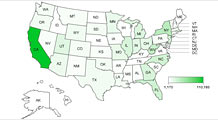The dam infrastructure problem
New report says over 1,800 dams pose significant risk to human life. Fixing them will cost billions, but can we afford this in addition to roads, bridges and other projects?
 |
| Kentucky's Wolf Creek Dam. How much longer will it hold? |
NEW YORK (CNNMoney.com) -- Kentucky's Wolf Creek dam has been a hazard for years.
Some 150 miles northwest of Nashville, the 270-foot high, 1950s era dam on the Cumberland River has been leaking for decades.
The problem seems to have gotten worse in recent years. The dam poses such a threat that in 2008 counties down river installed emergency evacuation horns.
Although the Army Corps of Engineers is working aggressively to fix the problem and says the dam should be stable in seven years, the consequences of a breach are huge. The pent-up water in Cumberland Lake would spread over over 200 miles - flooding Nashville. The Corps estimates over 100 lives could be lost, and cause over $3 billion in property damage.
It's against this backdrop that the American Society of Civil Engineers recently said over 1,800 dams nationwide are deficient, and their failure could result in loss of life. That's almost a five-fold increase from 2001.
"There's a huge gap between what we've been able to repair and what we need to repair," said Brad Iarossi, a dam safety manager who helped author the engineer society's report. "And the number has been growing dramatically."
The price tag to fix these worst-case dams is around $8 billion, said Iarossi. Fixing all the dams that need repair - estimated at over 4,000 - would run closer to $50 billion.
The question is: Do we need to spend all that money and how immediate is the threat?
The $50 billion would have to come out of money for roads, bridges, schools or other infrastructure projects.
And while a breach at Wolf Creek could be a serious situation, especially due to its proximity to Nashville, experts say most dam failures would be gradual and quite predictable.
"Although the numbers are alarming, there's nothing in this report that would suggest a disaster movie scenario," said Douglas McCoach, vice president of planning and urban design at RTKL Associates, an architecture and planning firm.
McCoach said focusing on the worst-case dams is a good idea, while gradually chipping away at the others on a piecemeal basis.
While the image of a huge Hoover Dam-type structure with a big crack in it is what most people think of when they hear the words "dam failure," in reality it's not usually that dramatic.
There are a handful of reasons engineers could deem a dam "deficient," said Iarossi, and they don't usually have to do with giant cracks.
It could be that the technology to predict earthquakes has gotten much better since the dam was built, and what was once though as a very unlikely event has gotten a bit more likely. In those cases, the dam needs to be strengthened structurally.
Or it could be that meteorology has improved. Old rainfall predictions that said flooding seemed unlikely, now may say flooding is more likely. That would mean the spillway, the part of a dam that allows water to flow over it without damaging the structure, needs expanding.
Or, like in the case of Wolf Creek, it could be that the dam is experiencing "seepage." That's where water is leaking into the dam's foundation and eroding the soil beneath it. But as with Wolf Creek, it's a problem that has gone on for decades and officials seem to be managing it.
"Dams generally don't collapse out of nowhere," said Martin Doyle, an assistant professor of geography at the University of North Carolina Chapel Hill. "It happens during flood events. People know it's coming, and they usually are evacuated."
Still, Doyle was quick to point to all the old dams across the United States, and say that sooner or later they will all need to be dealt with.
Most dams posing the greatest danger are in the eastern part of the country, for two reasons.
First, they tend to be older. But the eastern part of the country is also more densely populated. One of the reasons there's been such an increase in high risk dams, said Iarossi, isn't because the dam itself has deteriorated, but rather because more people have moved closer to it.
That increases the chances of loss of life or property in the event of a breach, and immediately bumps the dam up into a higher risk category even if the dam is in excellent condition.
The engineering society recommends more funds for dam repair and inspection, more emergency planning, and greater public education, among other things.
Fifty million dollars were set aside in the stimulus bill to repair dams run by the Department of Agriculture, but that's all that was allocated specifically for dam work, said Iarossi.
He's calling on Congress to approve $200 million to shore up the most dangerous dams over the next five years.
A small start, he said, but one that can begin to chip away at the problem. ![]()


